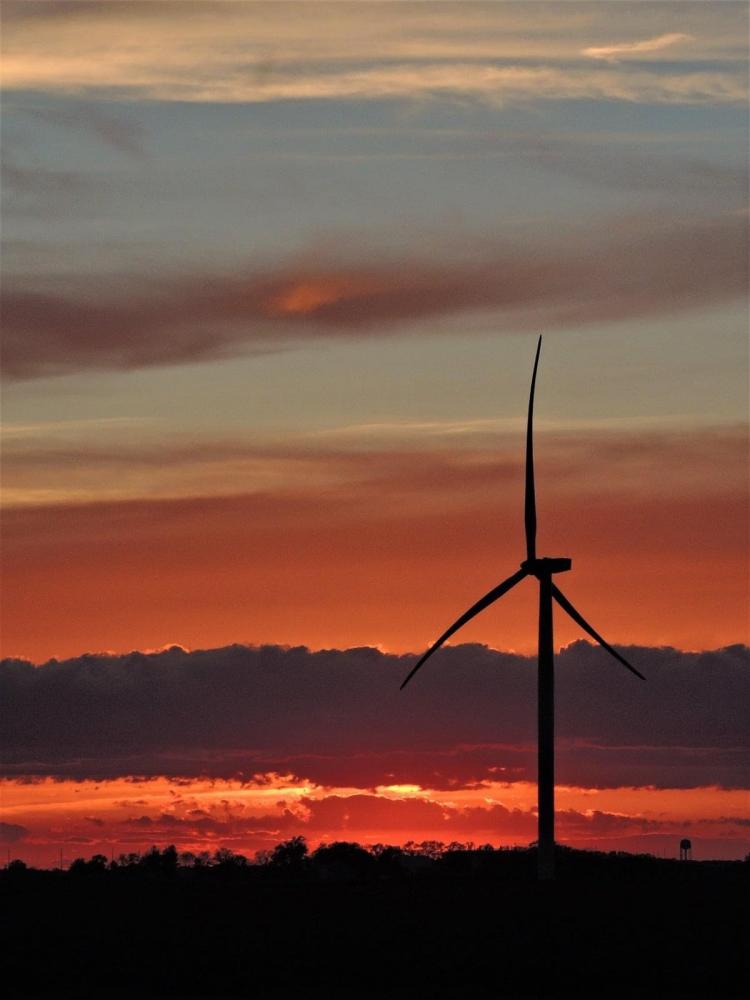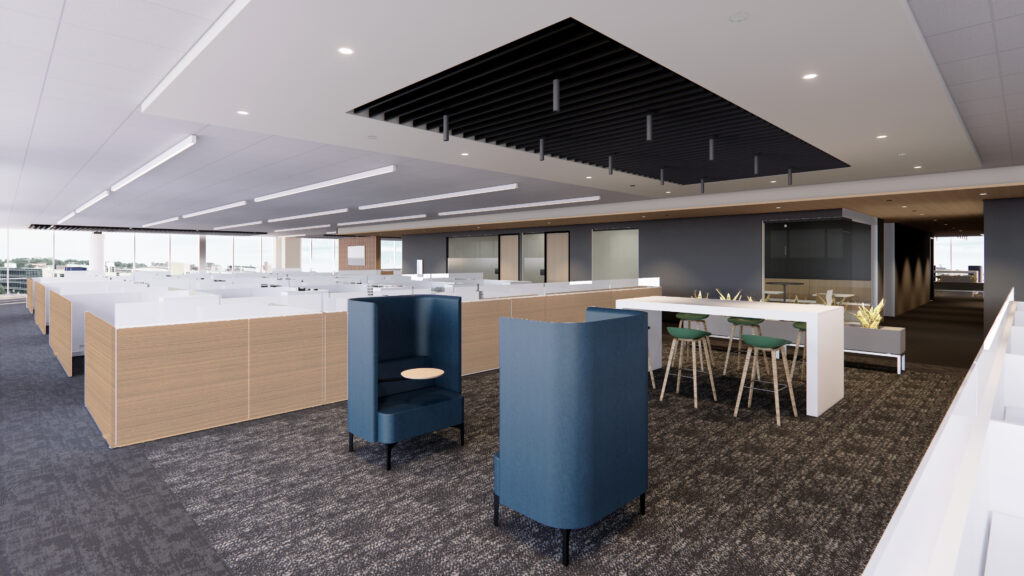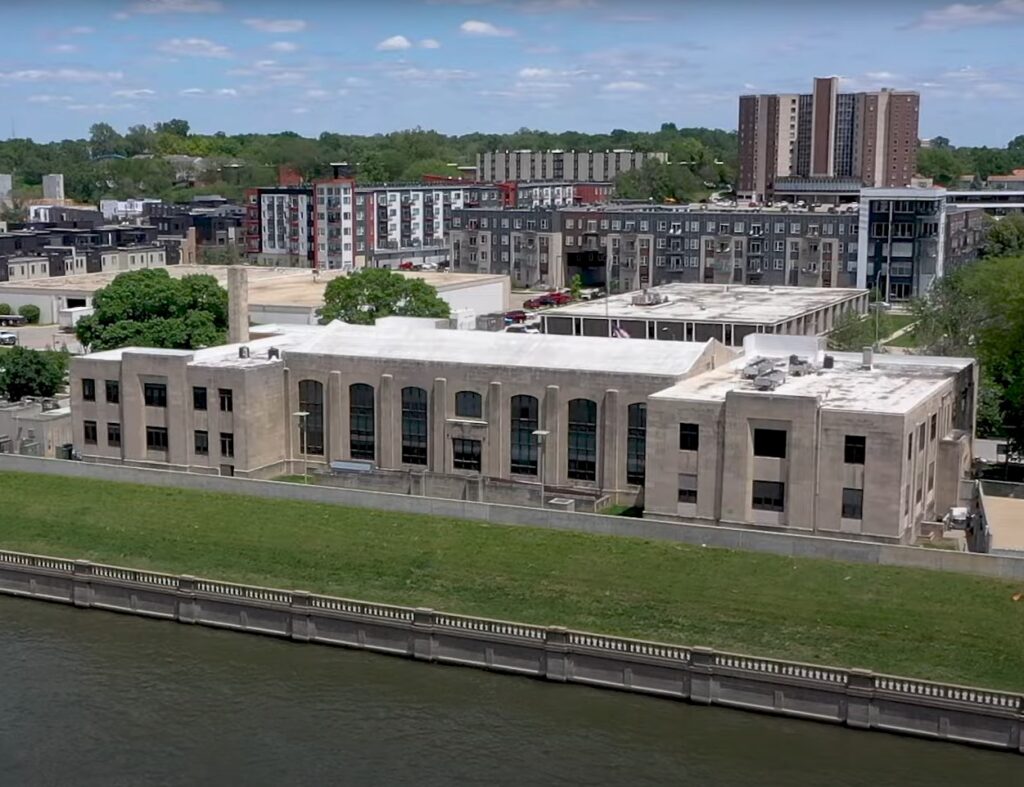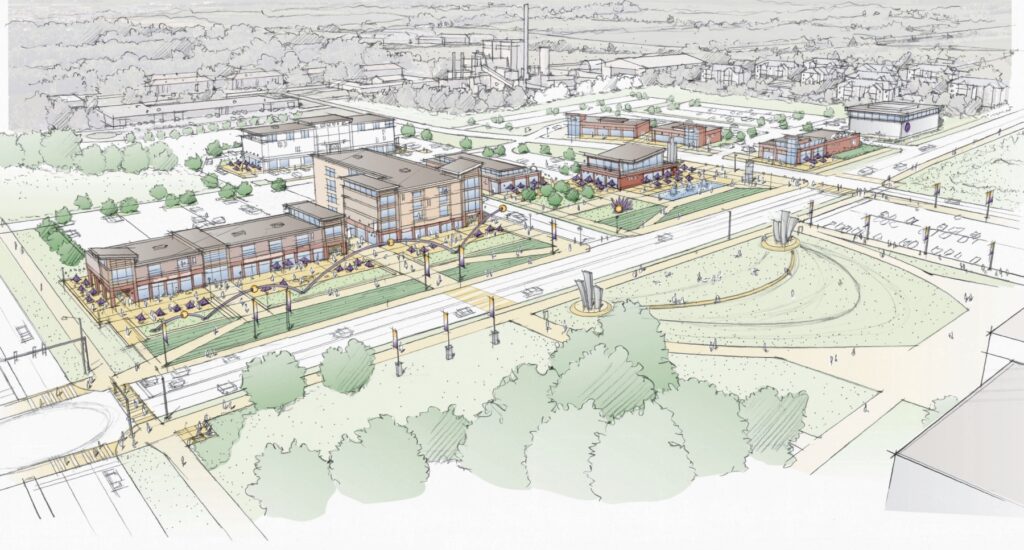Climate discussions sparks debate among Des Moines council, stakeholders

MICHAEL CRUMB Dec 8, 2020 | 4:32 pm
6 min read time
1,504 wordsAll Latest News, Energy, Government Policy and LawA wind turbine is silhouetted against a sunset north of Des Moines. Photo by Michael Crumb
The Des Moines City Council agreed Monday to continue working toward a resolution to update its plan to reduce carbon emissions, but did so after council members clashed over concerns about possible conflicts of interest and approaches.
During the work session, city officials heard from stakeholders, including representatives from MidAmerican Energy Co., who warned a move to 100% renewables could be costly to utility customers. No formal action was taken by the council, which directed staff to continue working on a clean energy resolution that would be brought forward for consideration at a later date.
Jeremy Caron, the city’s director of sustainability, said the latest 2020 residents surveyed showed that residents were least satisfied with progress the city was making toward reducing greenhouse gases and with the city’s efforts to conserve energy.
Caron said cities will be on the front line in the fight against climate change and that Des Moines is poised to be a leader in that effort because of its growth and destination for companies and people who want to locate here. That growth, Caron said, creates “a greater emphasis on how we use and where we get our energy.”
“That’s going to take a multi-faceted approach that includes multiple solutions from energy efficiency to renewable energy, the electrification of buildings and vehicles, and a host of other solutions to reduce greenhouse gas emissions,” Caron said.
He said actions taken locally have the greatest potential to create change.
“What we do now, or what we fail to do now, our children and grandchildren cannot change,” Caron said. “They do have the chance to improve upon whatever success we can achieve.”
Kathryn Kunert, vice president of economic connections and integration for MidAmerican, outlined efforts the company is making to increase production of renewable energy while reducing emissions from its coal-fired power plants. She emphasized the need to maintain an affordable, reliable and sustainable source of energy for MidAmerican’s customers.
The company announced its 100% Renewable Energy Vision in 2016, and started its Green Advantage Program. MidAmerican delivered renewable energy equivalent to 61.3% of customer usage in 2019. That is expected to increase to more than 83% this year and 90% in 2021, Kunert said.
Kunert said MidAmerican has reduced carbon emissions by more than 50% between 2005 and 2019. The company also has retired four coal plants across Iowa in the past 70 months, and continues to explore opportunities to increase sustainability of its energy production, such as solar and nuclear, she said.
But going 100% renewable would come at a cost, said Mike Fehr, vice president of renewable generation.
Fehr said a typical Des Moines customer would see their bill increase 3 ½ times its current level if demand is served entirely by renewable sources. A bill would increase by about 1 ½ times with a small nuclear module. Business and industrial customers would see similar increases in rates under those circumstances, Fehr said.
He said customers would see little effect under MidAmerican’s current plan without installing additional resources to serve Des Moines.
Kunert said MidAmerican is focused equally on environmental and social justice, emphasizing the need to keep energy affordable.
“Delivering affordable energy is especially critical for those who are most vulnerable as lower fixed incomes can be disproportionately affected by rising energy costs,” she said.
She said affordability, sustainability and reliability are needed to support the system.
“Because the wind doesn’t always blow and the sun doesn’t always shine, our renewable assets cannot solely be relied upon to provide the consistent and reliable power our customers need to power their lives,” Kunert said.
Kerrie Johannsen, energy program director of the Iowa Environmental Council, shared charts that showed increased wind energy production didn’t translate into reduced CO2 emissions, which rose in 2017 and 2018. That was tied to natural gas generation at the Alliant power plant in Marshalltown, but also increased coal generation those years, she said.
“Even if utilities generate enough wind to cover 100% of Iowa customers’ use on paper, but still run coal plants as back-up and sell coal energy into the market, our emissions could actually rise as we get closer to this 100% renewable vision,” Johannsen said.
She said the percentage of wind energy produced in Iowa has shifted from 8% wind energy generation and 74% coal generation, to 41% wind and 36% coal in 2019.
According to Johannsen, it will take between 30,000 and 60,000 megawatts and 5,000 to 20,000 megawatts of solar to decarbonize Iowa’s electric grid. Currently, the state has about 10,000 megawatts of wind and 200 megawatts of solar, she said.
Mayor Pro-tem Joe Gatto asked Johannsen if her numbers were specific to Des Moines, or the state as a whole. Johannsen said they were for the state and she did not have the breakdown for Des Moines.
“Your information is based on the state. You have no information based on the city of Des Moines, which you just presented us and that’s what we’re voting on, a resolution for the city of Des Moines residents,” Gatto said.
Business connection
The council also heard from Jason Steinbock, director of business development for consulting firm Willdan, who spoke about commercial buildings and how to reduce their energy loads as much as possible before employing clean energy technology.
Balancing demand loads with schedules, maintenance and availability of renewable resources is one challenge, he said.
“We have to think about shaping our energy use … to align with when the wind is blowing or when the sun may be shining,” he said. “We have to remember that people run these buildings. You have to think about the demand response of that building and the interactions of the building. It really changes the way buildings will have to be run.”
Heather Christensen, senior market research analyst and sustainability coordinator for Kemin Industries, is also a board member of Urban Ambassadors, which works to help individuals be more sustainable, and a member of the Mayor’s Sustainability Task Force.
“A 100% clean energy resolution provides a vision for Des Moines where we can be a leader in Iowa,” she said. “I think there’s a scientific consensus we need to cut our emissions in half by 2030 and then to zero by 2050, and this is something business is very much in line with.”
For Des Moines, 51% of emissions come from electricity, she said.
With alternatives for clean energy comes opportunities for jobs, Christensen said.
She said Kemin has created a sustainability scorecard, the biggest part of it being the company’s carbon footprint. The next step is to set “ambitious targets,” to align with the clean energy transition, she said.
As part of that, Kemin is building a solar array to entirely power its headquarters in downtown Des Moines. It represents one of the biggest corporate solar installations in the area, she said.
Christensen said it’s important to note that solar panels will not be enough to meet Kemin’s clean energy needs.
“There’s going to have to be a lot of other strategies we’re going to have to incorporate and partner on to make that possible,” she said.
Clash over ‘conflict of interest’
Councilman Josh Mandelbaum and Gatto clashed when Mandelbaum asked questions of the council and the stakeholders about their positions on the cause and solutions to the clean energy issue.
Mandelbaum had submitted a proposed resolution that the city set a goal of achieving 100% clean energy reliance by 2030, but Gatto said the resolution would create a perceived conflict of interest because Mandelbaum is an attorney for the Environmental Law & Policy Center in Des Moines, which supports renewable energy and reductions in greenhouse gas emissions.
“I think clearly we know where you stand on this, being this is your day job,” Gatto said. “You are lobbyists for environmental reasons. You won’t be writing any resolution that I’ll be agreeing to just because of the appearance of any conflict. That’s not to say that I disagree with you in any way, but you’ve got to be very careful. You are walking a very thin line, and you’re taking us all — as council members and your colleagues — down a path where there is an appearance of a conflict.”
“I disagree with your assessment,” Mandelbaum said.
Councilwoman Linda Westergaard also objected to Mandelbaum asking questions of panelists. “I don’t think it is appropriate to ask us questions right now,” Westergaard said. “I am not going to support the resolution you brought through.”
Gatto also shut down Mandelbaum when he asked if MidAmerican could achieve its renewable energy goals without closing its coal plants.
“This isn’t a call to call out MidAmerican on its coal plants that aren’t in the city of Des Moines and we don’t have any control over,” he said.
Kunert said earlier in the discussion that MidAmerican has retired four coal plants but needs to keep two online as back-ups and avoid rolling black-outs.











